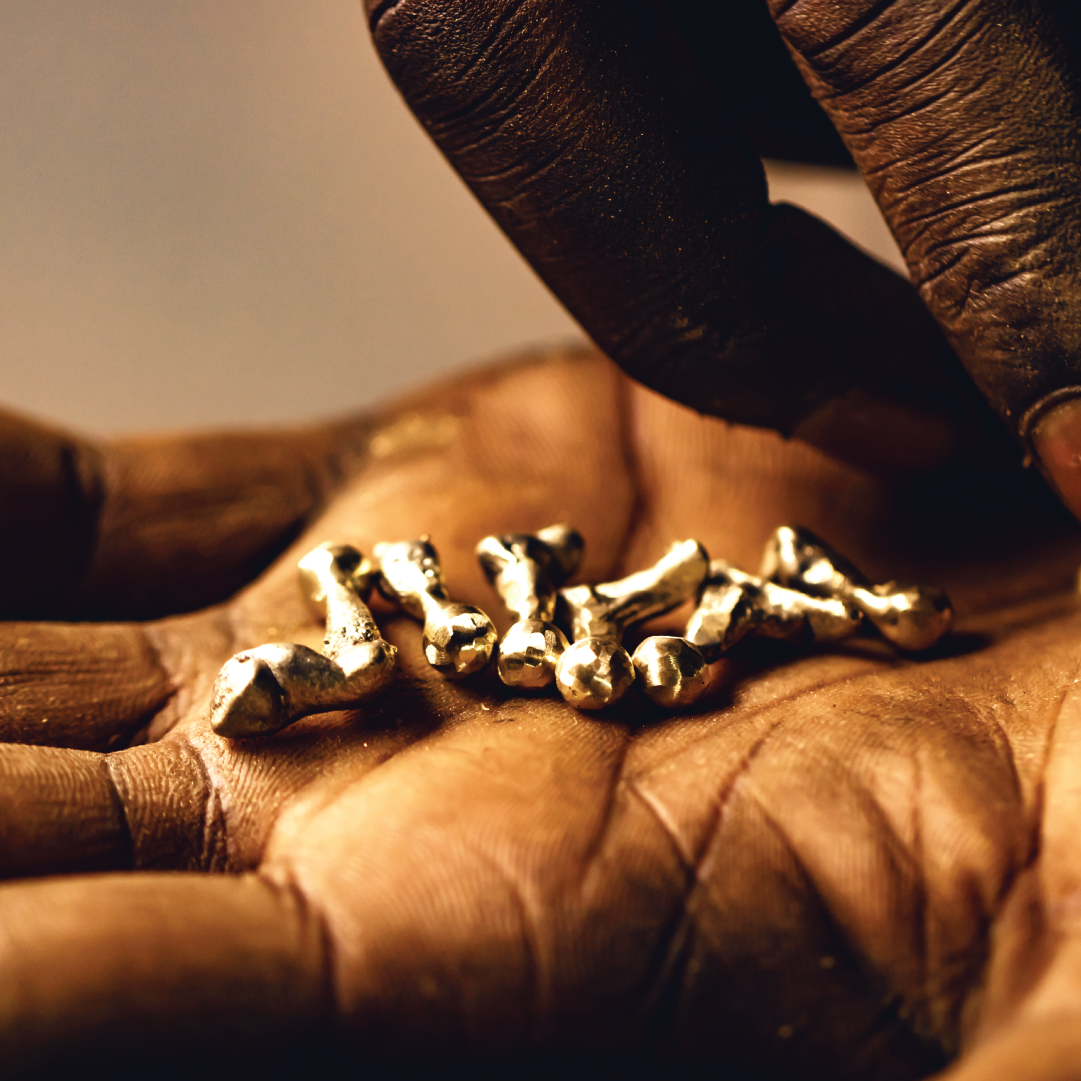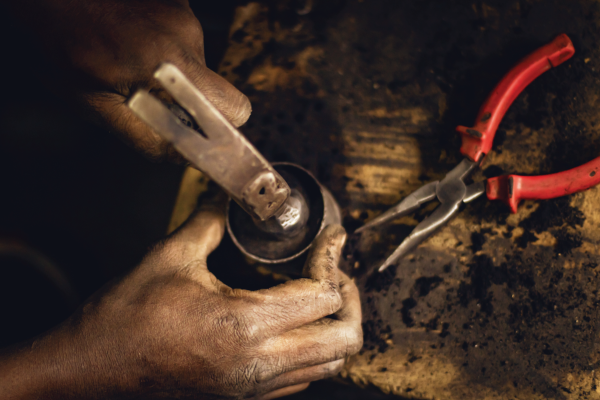
Share this Article

For years now, metal cuffs have been a mainstay of our beloved stack. With our first (but definitely not last) foray into brass jewelry, we wanted to take the metal cuff to the next level by adding an extra dimension with the addition of rounded metal adornments.
It takes three highly skilled artisan-entrepreneurs to create our Knobbed Metal Cuff. In the first of a multi-step process, Robert Olang sand casts the metal balls; Godfrey Wandera then shapes the metal for the cuff and solders the components together. For the final phase, Godfrey passes the completed cuff onto Wesley Eric Omino for coating and electroplating.
Here's a look at what it takes to make our flagship metal cuff.


Robert has found that the best sand for creating sand molds comes from the River Sagana, 100 kilometers north of Nairobi, the capital of Kenya, where he is based. He recently rented an additional space to allow him to buy and store a truckload (5 tonnes). This is enough for a year’s worth of work.
He starts the process by sieving the sand to remove any impurities.

Molasses, a thick syrup that is a by-product of sugar harvesting and production, and has a viscous consistency, is used as a binder.


With years of experience, Robert can estimate the perfect sand to molasses ratio. The mixture goes from a light brown to a deep, rich brown when it's fully incorporated.

The mixture is compacted around patterns used to form an imprint in the sand mold. The initial size and shape for the design is crafted from plaster. The mold is fired until it's hardened clay brick.

Robert runs a zero-waste workshop, and so he only uses recycled brass, which he buys from a scrap metal dealer. He collects anything from broken padlocks to old taps and belt buckles. With malleable durability, brass is the perfect material for jewelry making.

The brass scraps are melted in a clay oven that Robert custom built for purpose.


Once completely melted, the molten liquid is poured into the clay mold.

The brass cools almost immediately and can easily be separated from the clay mold.



To complete this part of the process, the cast metal balls go through six levels of sanding and polishing until they are absolutely smooth and perfectly rounded.


The brass stem is trimmed and only the perfect metal balls remain.


The length of brass for the full cuff is measured and then the shaped and refined piece by piece with the help of a wooden mandrel, hammer and pair of pliers.


The length between each metal ball is measured with a manual caliper and marked with a sharpie.

Godfrey works with a soldering stick and butane torch to connect the balls to the cuff. Tiny nickel solders and solder flux aid in the fusion.

Once all soldering is complete, the cuff is briefly dipped in a pickle acid to dissolve oxides, the flux, and any other metal residue from the soldering.

As a final step, to prepare the cuff for electroplating, the cuff Is buffed and polished to utter perfection.

THE CLEAR-COATED BRASS KNOBBED METAL CUFF


To ensure that the brass cuff has an extra special glean, and to avoid it tarnishing, we coat and seal it. The clear coating protects the cuff from oxidation brought on by exposure to air and moisture.
THE SILVER-COATED BRASS KNOBBED METAL CUFF
Electroplating is the process of transferring a surface layer of metal onto another type of metal. In this case, silver to brass.
A piece of copper is tied to the brass metal cuff, to act as a conductor before the cuff is lowered into a specialized electrolyte solution which is created using silver ions that an electrical current is passed through. After a short dip in the solution, the cuff is completely transformed.



As a young child, Robert suffered from epileptic seizures. Thanks to medical interventions, his epilepsy was effectively managed, and he hasn't had an episode since he was ten. It did, however, leave him with an enduring interest in medicine. In 2015, he joined the Kenya Medical Training College to study nursing. He started making jewelry and wooden homeware as a way to earn money as he studied. Last year, he qualified as a nurse. An impressive feat in and of itself, but more so that he built a business that now employs 12 artisans. And all before turning 30. Robert recently started a master's with a focus on renal care, but he has no plans to give up his artisanal endeavors. "The good thing about working in a hospital is that there are shifts. When I finish my shift, you will always find me here."
Godfrey Wandera Godfrey moved to Kenya's capital Nairobi from his home in Western Kenya at seventeen to look for work. Thanks to a cousin, he found work as a carpenter, not far from where he now owns and operates his studio and workshop. A few years ago, he seized the chance to move into jewelry when he had the opportunity to enroll in a business development program. Today, he focuses on making jewelry from brass, with reclaimed cow horn accents, either of his own design or on commission for the brands he works with like us.


Wesley Eric Omino Wesley studied Industrial Chemistry — a five-year course — and having spent the last ten years in the jewelry industry, he is one of the very few artisans in Kenya who have the knowledge and expertise to electroplate jewelry. He is the go-to for designers all across Kenya and East Africa. A serious, meticulous, and diligent scientist, Wesley's studio walls are chock-full with an interspersion of scientific formulas, affirmations, and inspirational quotes, like this one from Jeff Bezos that hangs above his desk:
I knew that if I failed, I wouldn't regret that, but I knew the one thing I might regret is not trying.
It has been an incredible honor for us to witness Wesley's alchemy first-hand and see how his expertise has taken our knobbed metal cuff to the next level.







1 comment
This is awesome. Great works by committed persons for a purpose. Keep up!